Eyeball Astronomy
Much of modern astronomy requires odd devices to detect signals that our bodies cannot sense - gravity, neutrinos, x-rays, γrays, microwave background radiation, but it is in the visual spectrum that we find the most visceral satisfaction with our [a]vocation. 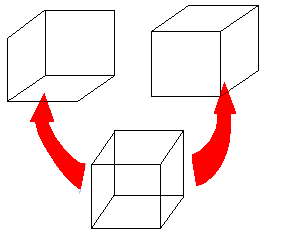 We spend a great deal of time trying to understand the optical systems that allow us to extend our vision many thousand fold but many of us know little about the penultimate optical system, the eye/brain system. It is in the eye/brain system where light becomes colors and images. It is here where we extract meaning from a chaos of signals.
We spend a great deal of time trying to understand the optical systems that allow us to extend our vision many thousand fold but many of us know little about the penultimate optical system, the eye/brain system. It is in the eye/brain system where light becomes colors and images. It is here where we extract meaning from a chaos of signals.
Notice that I have referred to the eye/brain system rather than the eye alone. The eye is composed of two dissimilar but cooperative portions, an optical focusing system and a light sensitive extension of the brain. Once light triggers a sensation, the nervous system begins a complex process of interpreting what is being seen. From four color sensitive selective chemicals and two essentially two dimensional images it constructs a full color three dimensional illusion which generally conforms well with the real world. However the eye/brain is easily fooled. All of us have seen line drawing optical illusions such as the line drawing that looks like a wire frame cube but which can tilt its positions as we look. We will discuss several optical illusions and effects you may not be aware of which have surprising astronomical impacts.
The Eye
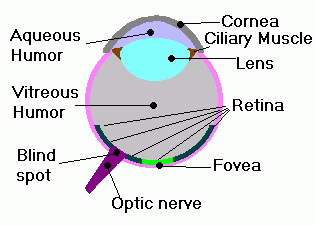 The eye is a wonderfully complex adaptive optical system which sees far better than the
sum of its parts. Understanding something about the eye can help you improve your own
viewing, several fold. Lets review a few basics about the eye. The outer clear layer is
the cornea, whose primary role is to keep the eye fluids in and the world out
without one hiding one from the other. The lens and the ciliary muscle
provide the classical optical system of the eye. The ciliary muscle changes the shape of
the lens creating a focusing mechanism which allows a single lens to focus close and far.
Failure of the lens and ciliary muscle to exactly focus cause many of us wear glasses for
either close or distant work. Between the cornea and the lens is a liquid, the aqueous
humor that provides both structural strength and a clean nutritive media for the
cornea. Behind the lens and the back wall is another fluid, the vitreous humor
which not only inflates the eyeball but acts as a filter to ultraviolet radiation.
The eye is a wonderfully complex adaptive optical system which sees far better than the
sum of its parts. Understanding something about the eye can help you improve your own
viewing, several fold. Lets review a few basics about the eye. The outer clear layer is
the cornea, whose primary role is to keep the eye fluids in and the world out
without one hiding one from the other. The lens and the ciliary muscle
provide the classical optical system of the eye. The ciliary muscle changes the shape of
the lens creating a focusing mechanism which allows a single lens to focus close and far.
Failure of the lens and ciliary muscle to exactly focus cause many of us wear glasses for
either close or distant work. Between the cornea and the lens is a liquid, the aqueous
humor that provides both structural strength and a clean nutritive media for the
cornea. Behind the lens and the back wall is another fluid, the vitreous humor
which not only inflates the eyeball but acts as a filter to ultraviolet radiation.
On the inside wall opposing the lens is the sensor system of the eye, the retina composed of:
- Fovea: Directly across the eye from the center of the lens is the fovea. The fovea is limited to about a one degree field of view. It is tightly packed with cells and has very acute vision.
- Peripheral Retina: Surrounding the fovea is the peripheral retina. The peripheral retina cannot focus as sharply as the fovea but it gives us a broad peripheral vision. When something of interest enters our peripheral field of vision it is reflexive for our eye to flick, centering the object in our fovea. Usually we are unaware of this but we can train our eye to avoid the reflexive centering movement.
- Blind Spot: The point at which the optics nerves exit the eye into the brain leaves a small area on the inner part of the eye which has no light sensitive cells. This part of the eye actually sees nothing but in the most common of optical illusions, we "fill in" the area mentally with an image from the surrounding background. A small red dot on a blue background appears blue if we center the red dot on the blind spot. It simply vanishes.
Once the nerves enter the brain, an amazing amount of processing is done which "corrects" the images we see, making sense of the world. The lens of the eye is seldom a perfect optical shape. If you photographed the image at the back of the eye, it would contain wavy irregularities. However, by the time we are aware of what we are seeing, these wavy irregularities are removed by processing in the brain. The amount of processing power is amazing. If you were to wear inverting prisms on your eyes continually for a few weeks, after a surprisingly short time, your brain will turn the upside down image upright again! After this adaptation, when you remove such prisms, it takes a while adjust back.
Light

Electromagnetic radiation is propagates in discrete packets called photons. Photons undulate in waves whose peaks may be millions of meters apart [long wave radio] to peaks separated by only quadrillionth of a meter [g radiation]. Photons with wavelengths in the spectrum between 400 and 700 nanometers are what we call visual light. While the word light may properly be used to refer to any part of the electromagnetic spectrum, we shall restrict it to mean visible light. Our eyes are limited to this narrow spectrum because the vitreous humor absorbs frequencies outside these bounds. Our bodies can detect some portions of the electromagnetic spectrum other than light. We detect infra red radiation as warmth. X-rays and ultra violet radiation causes severe burns and genetic damage. Some people can feel the strong long wave radio fields near power plants. Microwaves can disrupt our nervous system. However we cannot use our sensitivity to these parts of the electromagnetic spectrum to form images. Certain animals can see well beyond the wavelengths that we can see. Eagles see clearly in the ultra violet. Rattlesnakes can see with special organs called pits in the infra red.
In people older than one yea of age, UV is invisible because our vitreous humor absorbs these wavelengths. Museums which use UV lamps to cause fluorescent rocks to emit colored light have noticed a peculiar problem with infants. When an infant enters such a room, they generally become very distressed until someone covers their eyes. It has not been proven but we conjecture that their very immature eyes can see beyond the colors we know. These colors never seen in nature in dim surroundings are very disturbing to minds that refuse to accept this impossible color.
Photons have electrical and magnetic fields at right angles to each other. The orientation of these fields creates an attribute called polarization. Certain minerals and plastics have aligned arrays of atoms which preferentially allow polarized light to pass. While we cannot see polarization, insects can. They use it for determining where the Sun is on cloudy days. Viking mariners used lodestones (polarized crystals of mica) to find the Sun in poor weather as well.
Color
 When we look at a sufficiently brightly illuminated object, we perceive the sensation we
call color. If we look at a bright source radiating light at 570 nanometers in
wavelengths 1 we see the color
yellow. We might think that the color yellow is light at wavelengths near 570
nanometers, but we would be wrong. Yellow is a perception rather than a wavelength.
Anything that evokes the perception of yellow is yellow even if none of the light we
detect is anywhere 570 nanometers. We can place a tint pixel of red wavelength
light (say 670 nanometers) immediately adjacent to a green pixel (of perhaps
525 nanometers) and our eye will give us the illusion that we are seeing yellow.
This results from the processing that the brain does on the signals it receives from
adjacent cones sensitive to red and green light. It get the same intensity of red and
green as the yellow color would have evoked even though no yellow wavelengths of light are
involved. [The diagram is not accurately drawn but exaggerated to illustrate the point.]
When we look at a sufficiently brightly illuminated object, we perceive the sensation we
call color. If we look at a bright source radiating light at 570 nanometers in
wavelengths 1 we see the color
yellow. We might think that the color yellow is light at wavelengths near 570
nanometers, but we would be wrong. Yellow is a perception rather than a wavelength.
Anything that evokes the perception of yellow is yellow even if none of the light we
detect is anywhere 570 nanometers. We can place a tint pixel of red wavelength
light (say 670 nanometers) immediately adjacent to a green pixel (of perhaps
525 nanometers) and our eye will give us the illusion that we are seeing yellow.
This results from the processing that the brain does on the signals it receives from
adjacent cones sensitive to red and green light. It get the same intensity of red and
green as the yellow color would have evoked even though no yellow wavelengths of light are
involved. [The diagram is not accurately drawn but exaggerated to illustrate the point.]
In addition to colors which represent wavelengths that we could see in the spectrum of light (perhaps from a prism), we traditionally include the gray tones from black to white, the pastels, the tints and shades as colors. While violet is both a color and a portion of the light spectrum, purple is only a color. The sensation of purple arises from a mixture of blue and red colors that cannot be transmitted as a single wavelength of light. Color and light are intricately interwoven but they are not the same things.
Rods and Cones
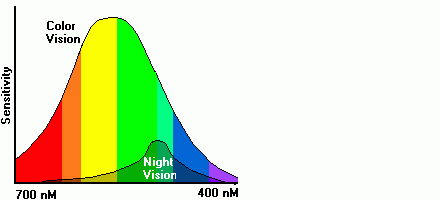
Our eyes have two separate types of light sensing cells, the rods and the cones. When a photon hits a vision cell, it partially charges the cell. The change dissipates over a brief time interval. If additional photons hit this same cell before the initial charge is exhausted, the charge builds until the nerve fires creating a perception of a point of light.
Cones:
- The fovea is composed almost entirely of cones.
- Cones sense colors using three filtering chemicals which have sensitivities which peak in the red, green and blue portions of the spectrum
- Cones require a higher rate of photons to trigger a sensation of light.
- Cones charge and discharge rapidly.
- Cones are most sensitive in the yellow green portion of the light spectrum.
Rods:
- The peripheral retina is almost entirely rods.
- The rods are loaded with a photochemical called rhodopsin [which translates as rosy red optical stuff]. Since rods have a single photo sensitive chemical, they see gray tones rather than colors.
- Rods operate in low light levels. Rods require fewer photons to create a sensation of light than cones.
- Rods charge and discharge more slowly than cones.
- Rods are most sensitive in the blue/cyan portion of the spectrum.
Purkinje2 and Other Optical Effects and Illusions
The behaviors of the rods and cones create a wide variety of optical illusions and effects. Most of these change the way we see astronomical objects. You will doubtless be familiar with many of these effects but you may be less familiar with others.
Night Vision
The most pronounced effect for astronomers is night vision. We all known that as the twilight deepens, there is a point at which one by one the colors disappear leaving us in a gray toned world. Bright stars may retain some of the hue but most stars appear white. The visible planets are all bright enough to retain traces of color. The Moon and Venus appear to be exceptions although as we all know both these objects tend to be shades of light gray even in the largest telescopes. What has happened is that we have switched over seeing primarily with the fovea to the peripheral retina. The rods which are naturally monochrome receptors show us a world in black, gray and white leaving the fovea unused except for the occasional bright colorful object.
Color Shifts
Some objects which dark shades in the daytime appear relatively brighter at night (and vice versa). As we know, the cones are most sensitive to the yellow/green portion of the spectrum while rods are more sensitive to cyan and blue. You can actually demonstrate this change in color sensitive by doing the following experiment. Pick up a magazine with a picture of something displaying many shades of color. Allow your eyes to adapt to the dark fully and study the picture. [If you can see color, try again in a more dimly lit room.] Look at areas to see which are bright and which are dark. Now look at the picture in full light. You will see a pronounced shift in the relative brightness of the areas. Parts of the image filled with reds, oranges and yellows will seem much more brightly illuminated that the increase in areas which are blue or violet.
The major astronomical effect is that we underweight the brightness of red stars and overweight the brightness of blue stars. If all the brilliance of Betelgeuse was emitted at the red wavelength that is actually the brightest wavelength, rather than partially spread into the yellows and greens, this brilliant star would be almost invisible! Yet it would shine just as brightly. This shifted illumination is also the reason why many photographs and CCD images result in stars which appear either much too bright or much too dim. Film is hypersensitive to blue, violet and ultraviolet light while CCD cameras are overly sensitive to red. Our eyes simply do not agree with either of them.
Three Dimensional Illusions
The rods and cones operate at different speeds. Rods take longer to generate an image than do the cones. Normally we are unaware of this as the eye fuses the two images, however it can be exploited for an induced three dimensional optical illusion which has applications for visual astronomy.
I first encountered this effect several years ago at a local garden and flower show. One display had a darkened room with ultra violet powered florescent "butterflies" that seemed to float about the room in a vivid three dimensional effect while you looked through glasses they provided. I could not figure out how the effect was done. Since full color was present, I assumed [incorrectly] that the glasses were polarizing and that the images were painted with some sort of polarization. When I looked at the butterflies without wearing the glasses, the illusion faded instantly and they simply looked like painted butterflies on the floors, walls and ceilings. At the time I noticed a definite color bias but thought little about it. The color seemed at varying distances [red and orange seemed closest, yellows and greens seemed a bit farther away and the blues and violets seem most remote ]. I also noted that it did not matter if I reversed the glasses left to right. The butterflies always seemed to be three dimensional with the reds closest and the violets the farthest from me.
Here is how this effect works. One eye looks through a clear flat lens. The other eye looks through a flat lens dark enough that in the low light of the butterfly room, only the rods are activated. You think that you see color with this eye but this is a result of the image fusing with color from the clear lens eye. Since the rods are slower in response than cones, what we see with them appears to shift slightly if the eye or the object move relative to each other. . Unlike the color fusion, the brain does not fuse stereoptic images. It assumes that all stereoptic image shifts are the result of three dimensional displacements (which is almost always the case).
So how does this affect astronomy except incidentally because both are interested in the optical effects of seeing? Just this, binocular eyepiece for telescopes with the right filters will trigger this effect in a major way. If you look at a double star like Albireo through a binocular filter with one eyepiece with an appropriate filter you get an exaggerated three dimensional perception. The yellow star will seem to move toward you and the blue star will move away. I suspect that good night binoculars should display this effect in bright double stars which are widely separated in hue.
This three dimensional effect has other significant effects in how we see the night sky. Red stars are proportionately dimmer than their blue counterparts. In fact, if all the light of a bright star like Betelgeuse were concentrated in the deep red end of the spectrum, we would have a difficult time seeing this bright star.
Averted Vision
Every experienced telescope user comes to appreciate the technique of averted vision. By moving the image of a faint object from the fovea to the peripheral retina moves the object is imaged with the rods which are four times as sensitive to dim shades and gradations of light. Practice and good technique can improve the observational skills of those using the eye alone as well as those at the eyepiece. After allowing your eye to become dark adapted, it is often possible to see many of the Messier Objects particularly those in the southern skies without optical aids.
Targeted Vision
Astronomers are so accustomed to using averted vision that they sometimes forget that it is not always a good idea. The fovea is our friend when it comes to resolving double stars. The density of cones is twice that of the rods increasing visual acuity proportionately. Additionally, when the double stars are bright enough to stimulate color reception, differences in the colors can be a huge advantage, as anyone who tries to split Albireo with a small telescope can attest.
Night Blindness
Every astronomer has cursed a bright flashlight or car headlight that destroyed his night vision. What happens is that rhodopsin, the color pigment in rods bleaches in bright daylight to avoid triggering peculiar optical effects when bright light is available. The green, cyan, blue and violet wavelengths are highly effective in bleaching rhodopsin. Red light, particularly very deep red with little or no orange in it, is a poor bleaching agent of rhodopsin. Once bleached it takes at least a quarter hour to recover all your night vision.
Day Blindness
Most of us are familiar with leaving a darkened theater and being dazzled by daylight. Some of this is due to the pupils of the eyes being opened wide. Some of the effects of being dazzled is due to the brain receiving an overload of signals from the fovea and the rods. Until the rhopdosin is bleached, we almost instinctively shield our eyes from the brightness.
Color Mixing

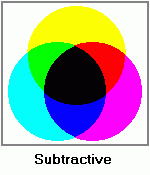 Some processes add wavelengths of light. For example shinning partly overlapping circles
of light from red, green and blue lamps onto a screen would give a pattern such as we see
to the left. We can also subtract light with filters. If we partially overlapped
a yellow, cyan and magenta filter and looked at a brightly lit white screen we would see
something approximating the diagram on the right side of this page. You may think that
subtractive processes are unlikely in nature but in fact they far outweigh source of
projected spectral illumination. A leaf filled with chlorophyll appears green because
chlorophyll does an efficient job of absorbing almost every spectral wavelength except for
a shade of green. Red paint absorbs almost every wavelength past orange. White clothes
are cool in the summer because they reflect almost every wavelength of light. Black roads
can be heated far too hot to be touched because they absorb a substantial amount of every
wavelength of light that falls on them.
Some processes add wavelengths of light. For example shinning partly overlapping circles
of light from red, green and blue lamps onto a screen would give a pattern such as we see
to the left. We can also subtract light with filters. If we partially overlapped
a yellow, cyan and magenta filter and looked at a brightly lit white screen we would see
something approximating the diagram on the right side of this page. You may think that
subtractive processes are unlikely in nature but in fact they far outweigh source of
projected spectral illumination. A leaf filled with chlorophyll appears green because
chlorophyll does an efficient job of absorbing almost every spectral wavelength except for
a shade of green. Red paint absorbs almost every wavelength past orange. White clothes
are cool in the summer because they reflect almost every wavelength of light. Black roads
can be heated far too hot to be touched because they absorb a substantial amount of every
wavelength of light that falls on them.
The cones behave as if they were composed of three separate colored pigments. I'll assume that this is the case although I don't know their names or chemical composition. In laboratory tests, the sensitivity of these three pigments are uneven. The red pigment has a wide range of frequencies to which it will respond. The green pigment has a somewhat narrower range of sensitivities. It also responds a bit more readily. The blue pigment has quite a narrow range in which it is sensitive. It is easily stimulated. The brain does a high wire act balancing the signals from each wavelength and arriving at an indication of the original color. For example some color with a modest amount of red, a bit more green and just a trace of blue would be treated as cyan (a light aquamarine color). A signal with no blue, a strong red level and a green level about half that strength would appear to us as orange. Add more green and that color now becomes yellow. A weak blue signal with no green or red appears to us as violet.
When an instrument like a spectrogram looks at a star, it creates many peaks and valleys. A star typically will have certain brilliant lines that correspond to specific types of atoms, possibly ionized. For example the red hydrogen alpha line is prominent in many stars, no matter what there overall color may be to the human eye. These types of instruments can tell us exactly how much of each wavelength of light we are receiving.
The human eye cannot perceive the star as many different colors. All the individual wavelengths together will stimulate each of the three primary color pigments to a certain degree. These three levels are passed into the brain where they are perceived as a single color. If there is too little light arriving, the cones will discharge before we perceive color. In such cases the rods may be able to perceive the star but in these cases it will always appear to be white. With bright stars, every frequency is well represented. The color looks like a particular color with a great deal of white added. It is unusual for a star to be so brilliant that it is distinctly any particular color. The closer the color comes to green, the more likely it is that the eye will see nearly every red, green and blue level at about the same intensity. Green stars [those just a thousand degrees hotter or so than the Sun] always look white to us.
The Chromaticity Diagram
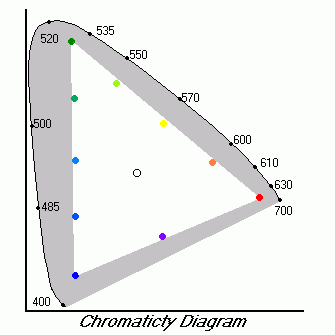 Engineers simplify the possible range of colors by using a {chromaticity diagram}. The
diagram shows the theoretically possible colors that might be seen by the human eye as
gray. The range of colors which are achievable for whatever system they are discussing
are show as an embedded white triangle. One aspect which is not shown on this diagram is
the intensity. Every point on this diagram shows the achievable colors at a specific
illumination. A large number of additional diagrams would be needed for other intensities
except that most real world system are approximately linear in their response and each
chromatic diagram would look like the next, so we only need a single diagram as long as we
understand that the intensity from nothing to fully saturated colors is not shown.
Engineers simplify the possible range of colors by using a {chromaticity diagram}. The
diagram shows the theoretically possible colors that might be seen by the human eye as
gray. The range of colors which are achievable for whatever system they are discussing
are show as an embedded white triangle. One aspect which is not shown on this diagram is
the intensity. Every point on this diagram shows the achievable colors at a specific
illumination. A large number of additional diagrams would be needed for other intensities
except that most real world system are approximately linear in their response and each
chromatic diagram would look like the next, so we only need a single diagram as long as we
understand that the intensity from nothing to fully saturated colors is not shown.
Notice the lower edge of the diagram. No specific wavelength of light is noted. Nominally this region is violet, but most three color primary monitors represent this part of the spectrum as a blend of blue and red. Since we have relatively poor discrimination in the violet part of the spectrum, the differences between purples (mixtures of red and blue) and violets (light whose wavelengths are shorter than blue) are not noticed.
This is not the case for other optical system besides the eye. Photographic plates are extremely sensitive to short wavelength light. In fact sources of ultraviolet and x-ray radiation will expose film more readily than visual light. In the other direction, CCD cameras are very sensitive to infra red radiation. CCD cameras have built in refrigerating unit to chill the CCD chip to avoid a hazy infra red over wash.
Color Deficits
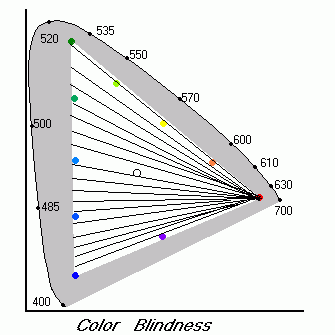 There are roughly 8% of the male population and 1/2%
of the female population that have an abnormality with these color pigments. This
referred to as color blindness where perhaps a more exact definition is color deprivation
because most of these people actually see colors. What happens in many cases is that it
affects the way the perceive colors. In the example shown, people with the form of color
deprivation called phanotropism see colors along the radiating lines as the same. They
can confuse reds with various colors but will not confuse greens and blues.
There are roughly 8% of the male population and 1/2%
of the female population that have an abnormality with these color pigments. This
referred to as color blindness where perhaps a more exact definition is color deprivation
because most of these people actually see colors. What happens in many cases is that it
affects the way the perceive colors. In the example shown, people with the form of color
deprivation called phanotropism see colors along the radiating lines as the same. They
can confuse reds with various colors but will not confuse greens and blues.
The implications for anyone at the telescope is obvious. If someone looks and sees a color which you know is orange and this person thinks the color is chartreuse, the person may have one of the forms of color blindness. Of course almost anyone can have the sensation that a faintly colored star is simply white. This is what happens when there is too little light to stimulate the fovea.
There is a strong correlation between sex and the ability to see shades of colors. About 90% of all women can distinguish various shades of color better than the average man. Men have sharper night vision. In dim light, most men can see better than most women.
I have seen well meaning people try to let visitors see the beautiful colors of certain stars. People with color deprivations simply will not see the same hues normal eyes will see. Don't frustrate your visitors if they have this problem.
Another lesser problem is that some people with nominally normal color vision require unusually bright light sources to stimulate color perception. This is particularly true in people with glaucoma or cataracts. Again, please allow these people to avoid the frustration of being told to look for something they will never see.
Acuity
Something which is often overlooked in eyeball astronomy is the acuity of the eye. There are people with far better than normal vision who can split doubles most of us see as single points of light and who can see objects dimmer than the traditional sixth magnitude. This used to be a matter of great importance. Today with binoculars available to almost everyone, this extra acuity is often overlooked. Using both superior resolution and superior sensitivity to light, there have been reports of the phases of Venus, the Galilean moons, up to 14 stars in the Plieades and reports of fuzzy patches where we know galaxies are to be found. Stars which we think of as being brighter or dimmer than nearby stars have been reported as reversed. Throughout most of recorded observations, people have talked about Castor being brighter than Pollux. Daytime skies were often described as violet rather than blue.
We know that some of these reports are wishful thinking today. However it is hard to disregard these reports when they preceded the invention of the telescope. Even today, at star parties, children often are the first ones to discern stars as the skies darken. Younger eyes are more sensitive to the blue end of the spectrum and these young eyes frequently see better than 20/20.
| If you wish to pursue this topic in more detail, I urge you to read Richard Feynmann's Lectures on Physics. |
1 The word wavelength is used throughout this discussion. We could have substituted the word frequency. The electromagnetic spectrum has a reciprocal relationship between wavelength and frequency. The frequency of a photon times its wavelength is the speed of light in a vacuum. The wavelengths of 400 to 700 nanometers are also the frequencies of 428 to 999 terahertz.
2 In the nineteenth century, the Czech physiologist (and patriot) Professor Johannes Evangilista Purkinje studied the human body. His discoveries are celebrated in the large number of body parts that are listed as purkinjean cells and purkinjean fibers. He extensively studied optical behaviors of the human eye even though he lacked most modern scientific investigative tools (chemical analysis, highly precise timers, nerve sensors, lasers). He discovered most of the optical effects and illusions mentioned in this essay. They are cumulatively known as the purkinjean effects.
